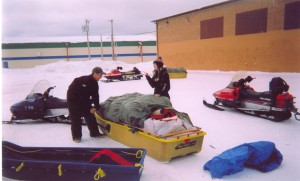Last Child in the Woods? Treating Nature-Deficit Disorder at a High School Winter Camp

Originally appears in the Winter 2007 issue
At no time in our species’ evolution have the young been so separated from nature. Obsessed with protecting children from any possible mishap, hovering “helicopter” teachers and guardians have not only alienated children from the natural world, but unknowingly taught them to fear it. This idea is spelled out eloquently in the recent book Last Child in the Woods by environmental writer Richard Louv.1 Citing a number of indicators, Louv demonstrates how separated from the elements the young have become. For example, the radius of the area where children play around their homes has shrunk dramatically in recent years. Indeed the very notion of playing outside — of romping in meadows and building tree houses — has almost disappeared in favor of scheduled activities like soccer practice and piano lessons. Too, “virtual reality” has distanced youngsters from nature, offering mediated rather than direct experience. In schools, outdoor recess has been drastically reduced in favor of more time spent in classrooms. Even life science courses are increasingly taught in stuffy laboratories and other indoor facilities.
Environmental teachers in particular have been called to account by those wishing to narrow the human-nature separation. “Prima-donna conservationists,” to use the term of one critic, have alienated the young from the wonders of the wild.2 Continual admonishments of “Don’t walk on the grass” and micromanagement of students’ behavior outdoors have effectively sent students the message “You’re here, nature’s there, and never the twain shall meet.”
The costs of this “nature-deficit disorder,” as Louv puts it, are many. He links the alienation to a number of physical and psychosocial maladies, including obesity, asthma, and attention-deficit disorder. As a result, he and others have called for a classroom liberation movement, freeing children from their bureaucratic prisons and leading them into the wild. His thesis is supported by numerous studies showing the positive effects of “wilderness therapy” on disorders in the young.3
This content is restricted to subscribers only.
If you are not yet a subscriber, please consider taking out a subscription here.
If you are an existing subscriber, kindly log in or contact us at info@greenteacher.com for more information.





